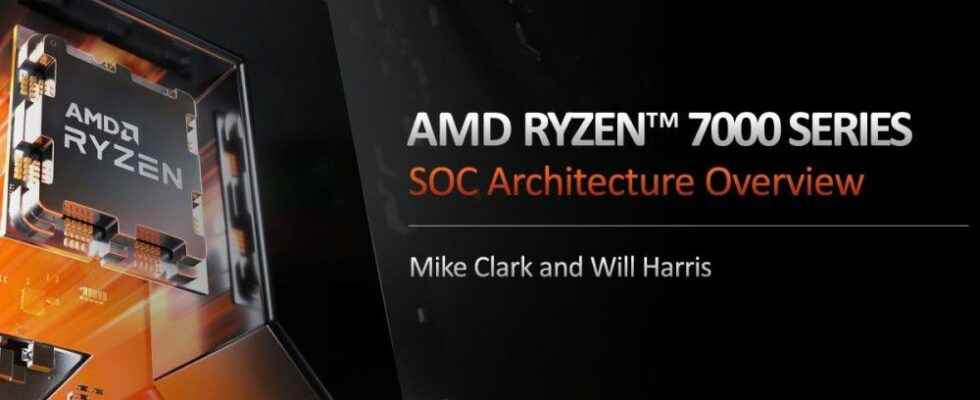AMD made these architectural changes from Zen 3 to Zen 4 for a 13 percent IPC increase.
Enlarge
Ryzen 7000 – Zen 4 Architecture Deep Dive
© AMD
AMD has neatly optimized the Ryzen 7000 processors under the hood to enable a 13 percent IPC increase. This includes changes to the frontend, the execution units, and the load and store units. By simultaneously increasing the maximum clock rate by up to 16 percent, the single-core performance is said to increase by up to 29 percent compared to the Zen 3. At the same time, the 7950X should be able to achieve up to 49 percent higher performance than the 5950X with the same power consumption. We take a look at what specific changes AMD has made.
AMD Ryzen 9 7900X in review
Zen 4 microarchitecture in detail
According to AMD, the following architectural changes led to the 13 percent IPC increase, in order of decreasing importance:
Font End: 2 branch predictions per cycle, 50% larger L1 branch target buffer, larger L2 branch target buffer, 68% larger OpCache and 9 (instead of previously 6) macro-ops from the OpCache
Load/Store: 22% larger load queue, 50% larger data translation lookaside buffer, fewer data port conflicts in cache
Execution units: 25% larger instruction queue, larger registers for integer and floating point operations, larger buffers
Doubled L2 cache per core from 512 kB to 1 MB
Added to this is the support of AVX512. This is a set of instructions that Intel introduced in 2020. The VNNI and BLOAT-16 instructions accelerate hardware-based AI workloads for neural networks and machine learning, among other things. However, the increase in clock rates provides the greatest increase in performance. Nominally, AMD specifies the boost clock of the Ryzen 9 7950X with up to 5.7 GHz, whereby the CPU can even reach up to 5.85 GHz. The maximum clock rate on all cores is 5.21 GHz.

However, AMD has not only worked on the CCDs, which TSMC manufactures in 5 nm, but also on the I/O die (6 nm TSMC). For the first time, an iGPU based on the RDNA 2 architecture is integrated as standard. This has 2 Compute Units (CUs) and masters the AV1 decoding. Displays can be connected via either HDMI 2.1 or DisplayPort 2.0. Furthermore, the memory controller now supports DDR5 RAM. The standard clock is 5200 MHz, but according to AMD the sweet spot is 6000 MHz.
Ryzen 7000 EXPO: what is it and what does it bring?
For optimal performance, the manufacturer recommends operating the memory controller with the same clock as the main memory. The Infinity Fabric is intended to be configured with the “Auto” setting. A 1:1:1 ratio of Fclk, Uclk and Mclk is therefore no longer recommended as with Zen 3. Furthermore, the CPUs now support USB-C with 10 Gbps and native USB BIOS Flashback.
